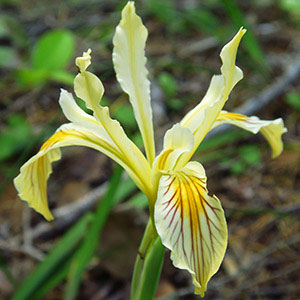Iris verna
Iris bracteata
dwarf violet iris
Siskiyou iris
heterogeneous, whitish, cordlike portions 0.1–1.5 dm × 2–4 mm, enlarging to 6–8 mm diam., densely covered with brown, scalelike leaves, roots absent, or torulose with roots borne along entire rhizome.
sheathed with old leaf bases, slender, 0.6–0.9 cm diam.;
roots few, fibrous.
simple, 5–15 cm.
simple, solid, 1.5–3 dm.
basal with blade light green, ensiform, 0.3–1.5 dm × 0.3–1.3 cm, enlarging to 3.5 dm, glaucous;
cauline 5–9, sheathing, imbricate, blade light green, obovate, 1.3–5 cm, increasing in length, proximal shortest, membranous, apex acute.
basal with abaxial surface of blades deep glossy green on one side of fan, light yellow-green on other side, pink or red-tinged basally, strongly ribbed, 4–6 dm × 0.8–1 cm, rigid, margins not thickened;
cauline 3–6, imbricated, closely sheathing stem ca. 2/3 length, spreading distally, bractlike, blade inflated, often shorter than basal leaves.
1–2-flowered;
spathes divergent, exposing floral tube, green, lanceolate, 2–2.5 cm, apex acuminate.
simple, units 1–2-flowered;
spathes closed tightly around pedicel and ovary, lanceolate, 5.2–9 cm × 6–8 mm, subequal, herbaceous, margins scarious, apex acuminate.
floral tube pale violet, filiform, 2.5–6.5 cm, expanding somewhat distally to 2.5–4 cm diam.;
sepals widely spreading, blue to violet with yellow or orange longitudinal papillose band at base of blade, obovate, 2–6 × 0.8–2 cm, base gradually attenuate into claw, not crested;
petals erect, arching inward at tip, spatulate, 2–7 × 1–2 cm, base abruptly attenuate into claw;
ovary linear, to 1.3 cm;
styles pale violet, 2.5–4 cm, crests linear-acute, narrow, 0.7 cm;
stigmas rounded, margins entire;
pedicel 1–3 cm, increasing to 25 cm as capsule matures.
perianth cream to buff-yellow;
floral tube 0.8–0.9 cm;
sepals with deeper yellow signal, veined with purple or brown, obovate-lanceolate, 6.5 × 2.5 cm, base gradually attenuate into wide claw;
petals narrowly oblanceolate, 7–9 × 0.8–2 cm, base gradually attenuate;
ovary nearly circular in cross section, 1.5–2.5 cm, base gradually attenuate into pedicel, apex abruptly acuminate into floral tube;
style 2.2–3 cm, crests spreading, yellow, not veined, 1.2 × 0.9–1.7 cm, margins toothed;
stigmas triangular or tongue-shaped, margins entire;
pedicel 3–6.2 cm.
3-angled with single ridge at each angle, almost hidden in bases of spathes, 1–3.2 × 0.8–1.5 cm, tapering into beak consisting of dried remnant of floral tube.
nearly circular in cross section, tapering abruptly at each end, 2–2.5 × 1–1.5 cm.
dark brown, ribbed, 2.8–3.2 mm, lustrous, with small, fleshy aril basally.
dark brown, irregular in shape, wrinkled.
= 40.
Iris verna
Iris bracteata
Varieties 2 (2 in the flora).
(Discussion copyrighted by Flora of North America; reprinted with permission.)
Iris bracteata is limited to one county each in northern California and southern Oregon. It hybridizes with I. chrysophylla, I. douglasiana, I. innominata, I. munzii, I. purdyi, and I. tenax.
(Discussion copyrighted by Flora of North America; reprinted with permission.)
1. Rhizomes 5–15 cm between offshoots; leaf blades 0.3–0.8 cm wide; capsules 1.2–1.8 cm. | var. verna |
1. Rhizomes 1.3 cm between offshoots; leaf blades 5–13 cm wide; capsules 2–3.2 cm. | var. smalliana |


